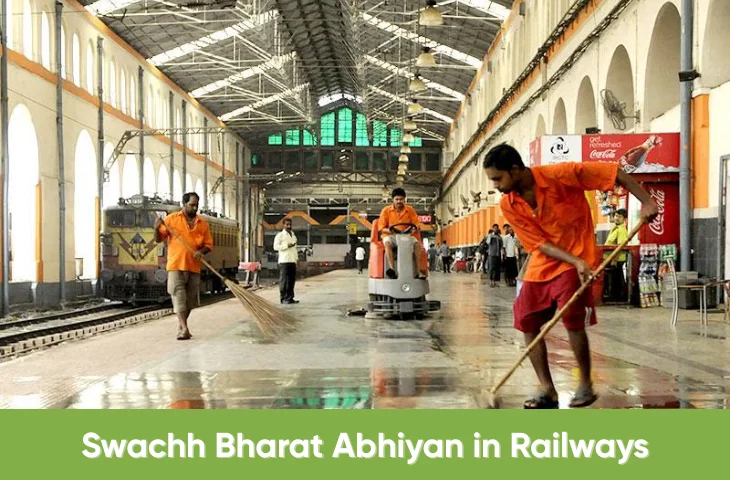Last updated on September 25th, 2025 at 04:42 pm
Swachh Bharat Abhiyan in Railways: Cleanliness is one of the most visible indicators of a nation’s development. Railways, being the lifeline of India and carrying millions of passengers daily, directly influence public perception of hygiene and sanitation. With the launch of the Swachh Bharat Abhiyan in railways, Indian Railways undertook a massive transformation journey to make railway stations, trains, and tracks cleaner and more passenger-friendly.
This article explores the objectives, implementation, achievements, and challenges of this ambitious cleanliness drive in Indian Railways.
Introduction to Swachh Bharat Abhiyan
Swachh Bharat Abhiyan (Clean India Mission) was launched on 2nd October 2014 by the Government of India to honor Mahatma Gandhi’s vision of a clean and hygienic nation. Its goals included:
- Eliminating open defecation.
- Ensuring solid waste management.
- Promoting behavioral change toward cleanliness.
- Improving sanitation in public places.
Given its massive daily footfall, Indian Railways was identified as a critical partner in realizing these goals.
Why Swachh Bharat Abhiyan in Railways is Crucial?
The Swachh Bharat Abhiyan is important to implement because of huge waste accumulation from passenger traffic, maintaining public image, and more. Check out the major reasons below:
- High Passenger Traffic: Over 23 million people travel daily, making stations prone to littering and waste accumulation.
- Vast Network: With more than 7,000 stations and 68,000+ km of tracks, managing cleanliness is a herculean task.
- Public Image: Stations and trains often serve as the first impression of India for foreign tourists.
- Health and Safety: Unhygienic conditions lead to the spread of diseases, especially in crowded environments.
Key Initiatives Under Swachh Bharat Abhiyan in Railways
Indian Railways adopted a multipronged strategy to ensure visible and sustainable cleanliness. Some of the key initiatives under the Swachh Bharat Abhiyan include:
1. Clean Stations
- Intensive cleaning and mechanized sweeping at major stations.
- Bio-toilets and modern restroom facilities.
- Plastic bottle crushing machines to promote recycling.
2. Clean Trains
- On-board housekeeping services in long-distance trains.
- Mechanized cleaning during halts.
- “Clean My Coach” SMS/online facility for passengers to request cleaning services.
3. Clean Tracks
- Elimination of direct discharge toilets.
- Regular track cleaning drives with special machines.
- Awareness campaigns to discourage littering from trains.
4. Waste Management
- Source segregation of waste at stations.
- Contracts with municipal bodies for garbage collection.
- Bio-waste treatment plants in select stations.
Technology and Innovation in Cleanliness
Indian Railways introduced several modern solutions to align with the Swachh Bharat Abhiyan in railways:
- Bio-toilets: Over 70,000 coaches fitted with bio-toilets to eliminate waste discharge on tracks.
- Automatic Coach Washing Plants (ACWP): For efficient cleaning of entire trains.
- CCTV Surveillance: Monitoring cleanliness at major stations.
- E-Procurement of Cleaning Services: Ensures transparency and accountability.
- App-based Feedback Systems: Passengers can report unhygienic conditions instantly.
Role of Passengers and Public Awareness
Railways actively involved passengers in the mission through:
- “Swachh Rail Swachh Bharat” campaigns.
- Wall paintings, hoardings, and announcements spread awareness.
- Engagement of school students, NGOs, and self-help groups in station cleanliness drives.
Monitoring and Evaluation
Indian Railways devised systems to measure progress under the cleanliness drive:
- Swachh Rail Portal: Records complaints and feedback.
- Station Cleanliness Survey of India: Annual ranking of stations based on cleanliness.
- Third-Party Audits: Independent agencies monitor cleanliness levels.
The top stations that maintain proper hygiene and cleanliness, as per the surveys are as follows:
| Year | Stations |
| 2018 | Jodhpur & Marwar (North Western Railway) |
| 2019 | Jaipur & Jodhpur (North Western Railway) |
| 2021 | Western Railway stations ranked top |
| 2023 | South Central Railway topped rankings |
Achievements of Swachh Bharat Abhiyan in Railways
There are various major achievements of Swachh Bharat in Railways. The major ones include:
- Complete Elimination of Open Discharge Toilets: Bio-toilets replaced direct discharge systems.
- Improved Passenger Satisfaction: Surveys reflect higher cleanliness ratings.
- Better Waste Management: Over 2,000 stations equipped with waste segregation bins.
- Cleaner Tracks: Significant reduction in track littering.
- Global Recognition: Indian Railways featured as a model for large-scale sanitation management.
Challenges Faced in Implementing the Abhiyan
Despite major achievements, certain challenges persist. The major challenges faced in implementing the Swachh Bharat Abhiyan are as follows:
- Behavioral Issues: Some passengers continue to litter despite awareness campaigns.
- Funding Constraints: Modern cleaning technologies require high investment.
- Manpower Shortages: Managing 7,000+ stations with limited staff is difficult.
- Plastic Waste Management: Large-scale elimination of single-use plastic remains a work in progress.
- Sustainability Concerns: Long-term upkeep of bio-toilets and mechanized plants requires consistent monitoring.
Comparative Analysis of Before and After Swachh Bharat Abhiyan in Railways
We have provided a comparative analysis table of the before and after Swachh Bharat Abhiyan in Indian Railways. Check out the details below:
| Aspect | Before 2014 | After SBA Implementation |
| Station Cleanliness | Manual sweeping, poor waste disposal | Mechanized cleaning, waste segregation, audits |
| Toilets in Coaches | Direct discharge onto tracks | 100% bio-toilets installed |
| Passenger Participation | Limited | Active through apps, awareness campaigns |
| Track Conditions | Heavily littered, unhygienic | Cleaner, reduced littering |
| Technology Adoption | Minimal use of machines | ACWPs, CCTVs, mobile apps, waste plants |
Future Planning of the Abhiyan
To sustain and expand the impact of Swachh Bharat Abhiyan in railways, the following measures are crucial:
- Automation Expansion: More coach washing plants and robotic cleaning systems.
- Plastic-Free Stations: Strict enforcement of plastic ban policies.
- Community Involvement: Strengthen ties with local bodies and NGOs.
- Digital Tracking: Wider use of apps for real-time cleanliness reporting.
- Green Energy Integration: Solar-powered waste treatment and recycling plants.
The success of Swachh Bharat Abhiyan in railways reflects how a large public sector institution can transform itself with clear vision, technology adoption, and public participation. While challenges remain, the visible improvement in cleanliness at stations, trains, and tracks has enhanced passenger comfort and national pride.
FAQs
Swachh Bharat Abhiyan (Clean India Mission) was launched on 2nd October 2014 by the Government of India to honor Mahatma Gandhi’s vision of a clean and hygienic nation.
The main goals of Swachh Bharat Abhiyan include:
Eliminating open defecation.
Ensuring solid waste management.
Promoting behavioral change toward cleanliness.
The Swachh Bharat Abhiyan is important to implement because of huge waste accumulation from passenger traffic, maintaining public image, and more
The major challenges faced in implementing the Swachh Bharat Abhiyan include behavioural issues, funding constraints, manpower shortages, and more.
The success of Swachh Bharat Abhiyan in railways reflects how a large public sector institution can transform itself with clear vision, technology adoption, and public participation.

Hello! This is Arijit Dutta. I am a skilled Content Writer at Oliveboard with nearly 3+ years of experience in crafting engaging, informative, and exam-focused content for the Railways Domain. With a strong command of language and a keen understanding of learner needs, I contribute significantly to Oliveboard’s mission of delivering high-quality educational resources. Passionate about clear communication and continuous learning, I consistently create content that helps government job aspirants achieve their goals. Outside of work, I enjoy playing cricket and listening to music, which helps me stay balanced and creative in my professional journey.
